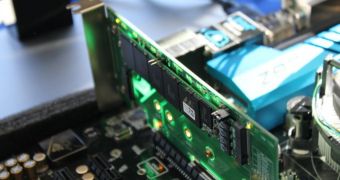Plextor showed the M7e PCIe Express at Computex this year and announced an update on the following release calendar. Aiming for the M7e release in Q3 means that it'll likely come during the Flash Memory Summit in August.
According to Anandtech, the specs will probably not change since its initial presentation, as the M7e still uses the same Marvell PCIe 2.0 x4 AHCI controller with 1.4GB/s read and 1GB/s write, with 125K random read and 140K write IOPS. At launch, the M7e will be available in both M.2 and PCIe formats with standard capacities ranging from 256GB to 1TB, the M7e being probably the first M.2 2280 drive to actually get 1TB for storage space.
However, competition from Intel and recently G.Skill is tough, as they strike with classic PCIe form factors with up to 2TB of memory with around 2GB read/write speeds. Nevertheless, on the M.2 form factor, they are all lagging behind, with G.Skill at least having no M.2 SSD in perspective, while Intel offers only max 480GB on the 530/535 series.
Older tech may prove to be a challenge
But this is cutting-edge technology that offers the same PCIe 3.0 and SATA 3.0 interface but in a much smaller and compact size, allowing more space for either increased memory size or multiple other SSDs connected to the same interface.
However, with the introduction of the U.2 by Intel, the M.2 will remain tied strictly with the mobile market, like tablets or mobile phones, thanks to its compact nature, whereas the U.2 will be kept for performance and high speed SSDs.
To familiarize yourselves, the M.2 specification provides four PCI Express lanes and one SATA 3.0 (6 Gbit/s) port, exposed through the same connector, allowing use of both PCI Express and SATA storage devices in the form of M.2 cards. Exposed PCI Express lanes provide a pure PCI Express connection to the storage device, without any additional layers of bus abstraction.
In other words, it's smaller, it's faster and you don't need SATA wires to plug it in your motherboard.

 14 DAY TRIAL //
14 DAY TRIAL //